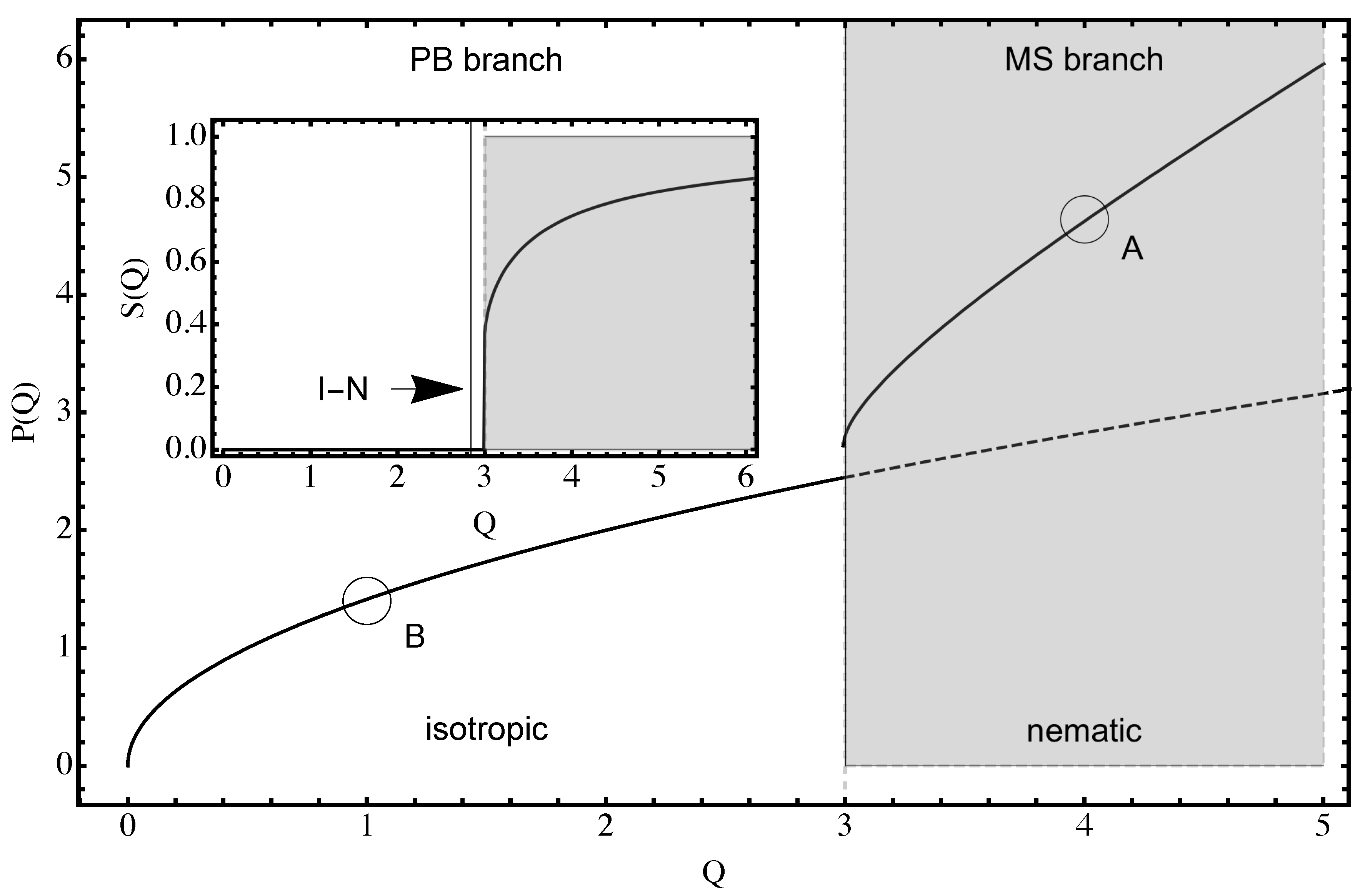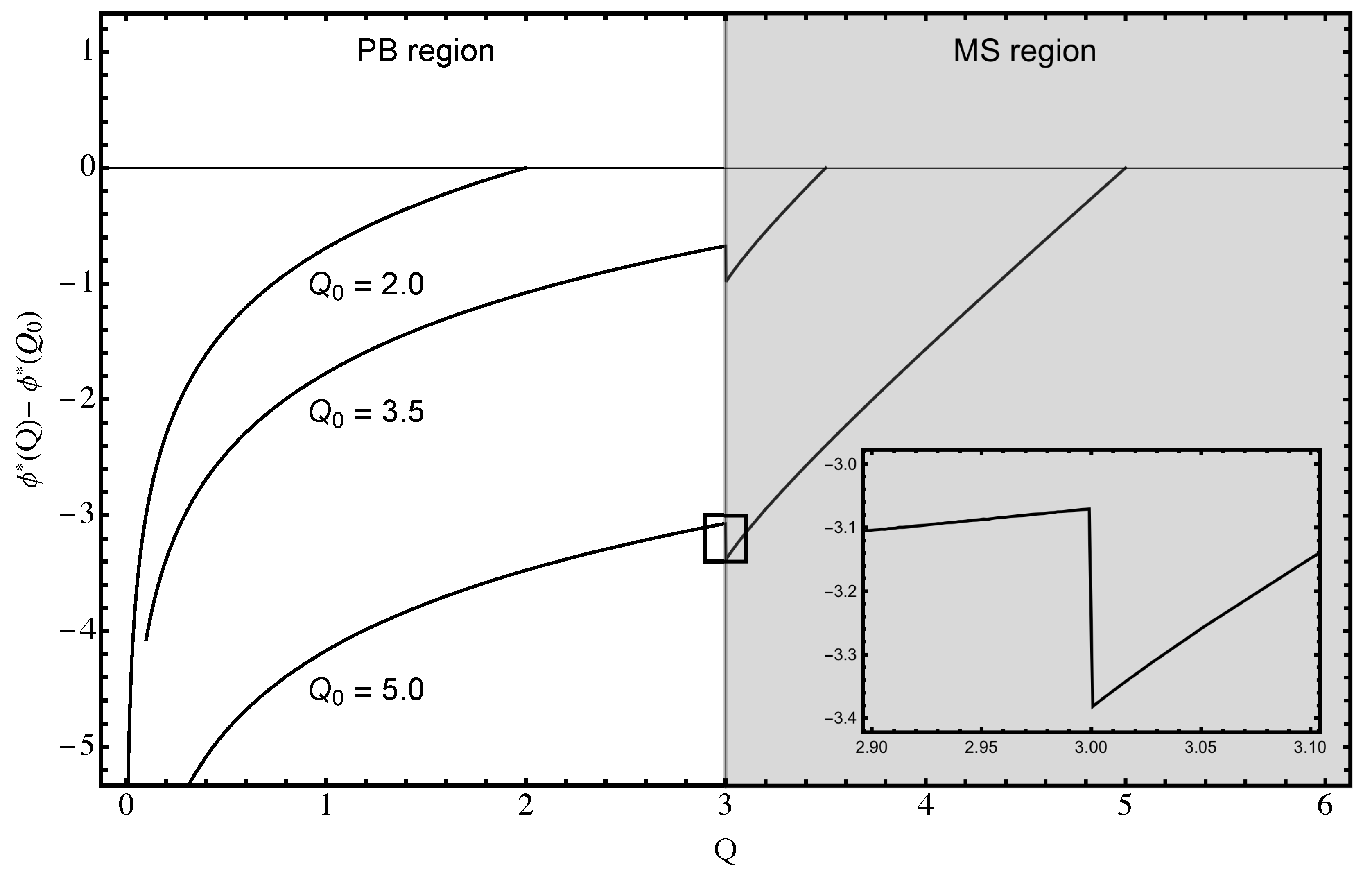Theory of Inhomogeneous Rod-like Coulomb Fluids
Abstract
:1. Introduction
2. Collective Description and Field Theoretic Representation
2.1. Order Parameters
2.2. Field Theoretical Representation and Thermodynamic Relations
2.3. Saddle-Point Approximation
3. Rod-Like Counterion-Only System in One Dimension
3.1. Coupled System of Maier–Saupe and Poisson–Boltzmann Equations
3.2. First Integral and the Phase Portrait Analysis
3.3. Dimensionless Counterion Density and Electrostatic Potential
4. Discussion and Conclusions
Funding
Institutional Review Board Statement
Informed Consent Statement
Data Availability Statement
Acknowledgments
Conflicts of Interest
Appendix A
References
- Bernal, J.; Fankuchen, I. The isotropic-nematic transition in charged liquid crystals. J. Gen. Physiol. 1941, 25, 147–165. [Google Scholar] [CrossRef] [Green Version]
- Šiber, A.; Božič, A.L.; Podgornik, R. Energies and pressures in viruses: Contribution of nonspecific electrostatic interactions. Phys. Chem. Chem. Phys. 2012, 14, 3746. [Google Scholar] [CrossRef] [PubMed] [Green Version]
- Busseron, E.; Ruff, Y.; Moulin, E.; Giuseppone, N. Supramolecular self-assemblies as functional nanomaterials. Nanoscale 2013, 5, 7098–7140. [Google Scholar] [CrossRef] [PubMed] [Green Version]
- Culver, J.N.; Brown, A.D.; Zang, F.; Gnerlich, M.; Gerasopoulos, K.; Ghodssi, R. Plant virus directed fabrication of nanoscale materials and devices. Virology 2015, 479–480, 200–212. [Google Scholar] [CrossRef] [Green Version]
- Rong, J.; Niu, Z.; Lee, L.A.; Wang, Q. Self-assembly of viral particles. Curr. Opin. Coll. Interface Sci. 2011, 16, 441–450. [Google Scholar] [CrossRef]
- Yang, S.H.; Chung, W.J.; McFarland, S.; Lee, S.W. Assembly of Bacteriophage into Functional Materials. Chem. Rec. 2013, 13, 43–59. [Google Scholar] [CrossRef] [PubMed]
- Tang, J.X.; Wong, S.; Tran, P.T.; Janmey, P.A. Counterion induced bundle formation of rodlike polyelectrolytes. Ber. Bunsenges. Phys. Chem. 1996, 100, 796. [Google Scholar] [CrossRef]
- Bellini, T.; Cerbino, R.; Zanchetta, G. DNA-based soft phases. Top. Curr. Chem. 2012, 318, 225–279. [Google Scholar] [CrossRef]
- Sanders, L.K.; Xian, W.; Guáqueta, C.; Strohman, M.J.; Vrasich, C.R.; Luijten, E.; Wong, G.C.L. Control of electrostatic interactions between F-actin and genetically modified lysozyme in aqueous media. Proc. Natl. Acad. Sci. USA 2007, 104, 15994–15999. [Google Scholar] [CrossRef] [Green Version]
- Needleman, D.J.; Ojeda-Lopez, M.A.; Raviv, U.; Miller, H.P.; Wilson, L.; Safinya, C.R. Higher-order assembly of microtubules by counterions: From hexagonal bundles to living necklaces. Proc. Natl. Acad. Sci. USA 2004, 101, 16099–16103. [Google Scholar] [CrossRef] [PubMed] [Green Version]
- Teif, V.B.; Bohinc, K. Condensed DNA: Condensing the concepts. Prog. Biophys. Mol. Biol. 2011, 105, 208–222. [Google Scholar] [CrossRef] [PubMed]
- Kanduč, M.; Naji, A.; Jho, Y.S.; Pincus, P.A.; Podgornik, R. The role of multipoles in counterion-mediated interactions between charged surfaces: Strong and weak coupling. J. Phys. Condens. Matter 2009, 21, 424103. [Google Scholar] [CrossRef] [PubMed] [Green Version]
- Bohinc, K.; Lue, L. The Interaction Between Like-Charged Nanoparticles Mediated by Rod-Like Ions. J. Nanosci. Nanotechnol. 2015, 15, 3468–3475. [Google Scholar] [CrossRef]
- Kanduč, M.; Naji, A.; Jho, Y.S.; Pincus, P.A.; Podgornik, R. Charged nanorods at heterogeneously charged surfaces. J. Phys. Condens. Matter 2018, 149, 134702. [Google Scholar]
- Alvarez Fernandez, A.; Kouwer, P. Key Developments in Ionic Liquid Crystals. Int. J. Mol. Sci. 2016, 17, 731. [Google Scholar] [CrossRef] [Green Version]
- Shi, R.; Wang, Y. Dual Ionic and Organic Nature of Ionic Liquids. Sci. Rep. 2016, 6, 19644. [Google Scholar] [CrossRef] [PubMed] [Green Version]
- Goossens, K.; Lava, K.; Bielawski, C.W.; Binnemans, K. Ionic Liquid Crystals: Versatile Materials. Chem. Rev. 2016, 116, 4643–4807. [Google Scholar] [CrossRef] [PubMed]
- Deutsch, J.M.; Goldenfeld, N.D. Ordering in charged rod fluids. J. Phys. A Math. Gen. 1982, 15, L71–L73. [Google Scholar] [CrossRef]
- Deutsch, J.; Goldenfeld, N. The isotropic-nematic transition in charged liquid crystals. J. Phys. 1982, 43, 651–654. [Google Scholar] [CrossRef] [Green Version]
- Odijk, T. Theory of Lyotropic Polymer Liquid Crystals. Macromolecules 1986, 19, 2313. [Google Scholar] [CrossRef]
- Der Schoot, P.V.; Odijk, T. Structure factor of a semidilute solution of rodlike macromolecules. Macromolecules 1990, 23, 4181–4182. [Google Scholar] [CrossRef]
- Vroege, G.J.; Lekkerkerker, H.N.W. Phase transitions in lyotropic colloidal and polymer liquid crystals. Macromolecules 1992, 55, 1241–1309. [Google Scholar] [CrossRef]
- Wensink, H.H.; Trizac, E. Generalized Onsager theory for strongly anisometric patchy colloids. J. Chem. Phys. 2014, 140, 024901. [Google Scholar] [CrossRef] [Green Version]
- Constantinescu, A.; Jho, Y. Nematic Phase Emergence in Solutions of Similarly Charged Rodlike Polyelectrolytes. J. Phys. Soc. Jpn. 2014, 83, 014002. [Google Scholar] [CrossRef]
- Bruinsma, R. Liquid crystals of polyelectrolyte networks. Phys. Rev. E 2001, 63, 061705. [Google Scholar] [CrossRef]
- Eggen, E.; Dijkstra, M.; van Roij, R. Effective shape and phase behavior of short charged rods. Phys. Rev. E 2009, 79, 041401. [Google Scholar] [CrossRef] [PubMed] [Green Version]
- Potemkin, I.I.; Khokhlov, A.R. Nematic ordering in dilute solutions of rodlike polyelectrolytes. J. Chem. Phys. 2004, 120, 10848–10851. [Google Scholar] [CrossRef] [PubMed]
- Lue, L. A variational field theory for solutions of charged, rigid particles. Fluid Phase Equilib. 2006, 241, 236–247. [Google Scholar] [CrossRef]
- Carri, G.; Muthukumar, M. Attractive interactions and phase transitions in solutions of similarly charged rod-like polyelectrolytes. J. Chem. Phys. 1999, 111, 1765. [Google Scholar] [CrossRef]
- Levy, A.; Andelman, D.; Orland, H. Dipolar Poisson-Boltzmann approach to ionic solutions: A mean field and loop expansion analysis. J. Chem. Phys. 2013, 139, 164909. [Google Scholar] [CrossRef]
- Buyukdagli, S.; Ala-Nissila, T. Microscopic formulation of nonlocal electrostatics in polar liquids embedding polarizableions. Phys. Rev. E 2013, 87, 063201. [Google Scholar] [CrossRef] [PubMed] [Green Version]
- Frydel, D. Mean Field Electrostatics Beyond the Point Charge Description; Wiley Pub.: Hoboken, NJ, USA, 2016; pp. 209–260. [Google Scholar]
- Ravnik, M.; Everts, J. Topological-Defect-Induced Surface Charge Heterogeneities in Nematic Electrolytes. Phys. Rev. Lett. 2020, 125, 037801. [Google Scholar] [CrossRef] [PubMed]
- Bier, M. Interfaces in Fluids of Charged Platelike Colloids. Ph.D. Thesis, Max-Planck-Institut fuer Metallforschung, Stuttgart, Germany, 2007. [Google Scholar]
- Kondrat, S.; Bier, M.; Harnau, L. Phase behavior of ionic liquid crystals. J. Chem. Phys. 2010, 132, 184901. [Google Scholar] [CrossRef] [Green Version]
- Bier, M.; Harnau, L.; Dietrich, S. Free isotropic-nematic interfaces in fluids of charged platelike colloids. J. Chem. Phys. 2005, 123, 114906. [Google Scholar] [CrossRef] [PubMed] [Green Version]
- Bier, M.; Harnau, L.; Dietrich, S. Surface properties of fluids of charged platelike colloids. J. Chem. Phys. 2006, 125, 184704. [Google Scholar] [CrossRef] [PubMed] [Green Version]
- Abrashkin, A.; Andelman, D.; Orland, H. Dipolar Poisson-Boltzmann Equation: Ions and Dipoles Close to Charge Interfaces. Phys. Rev. Lett. 2007, 99, 077801. [Google Scholar] [CrossRef] [PubMed] [Green Version]
- Azuara, C.; Orland, H.; Bon, M.; Koehl, P.; Delarue, M. Incorporating Dipolar Solvents with Variable Density in Poisson-Boltzmann Electrostatics. Biophys. J. 2008, 95, 5587–5605. [Google Scholar] [CrossRef] [Green Version]
- Buyukdagli, S.; Blossey, R. Dipolar correlations in structured solvents under nanoconnement. J. Chem. Phys. 2014, 140, 234903. [Google Scholar] [CrossRef] [Green Version]
- Slavchov, R.I.; Ivanov, T.I. Quadrupole terms in the Maxwell equations: Born energy, partial molar volume, and entropy of ions. J. Chem. Phys. 2014, 140, 074503. [Google Scholar] [CrossRef]
- Kim, Y.W.; Yi, J.; Pincus, P.A. Attractions between Like-Charged Surfaces with Dumbbell-Shaped Counterions. Phys. Rev. Lett. 2008, 101, 208305. [Google Scholar] [CrossRef]
- Frenkel, D. Statistical Mechanics of Liquid Crystals. In Liquides, Cristallisation et Transition Vitreuse = Liquids, Freezing and Glass Transition: Les Houches, Session LI, 3–28 juillet 1989; Hansen, J.-P., Levesque, D., Zinn-Justin, J., Eds.; Elsevier Science Publishers B.V.: Amsterdam, The Netherlands, 1991; pp. 693–759. [Google Scholar]
- Lebwohl, P.A.; Lasher, G. Nematic-Liquid-Crystal Order—A Monte Carlo Calculation. Phys. Rev. A 1972, 6, 426–429. [Google Scholar] [CrossRef]
- Lu, B.S. Multiscale approach to nematic liquid crystals via statistical field theory. Phys. Rev. E 2017, 96, 022709. [Google Scholar] [CrossRef] [PubMed] [Green Version]
- Doi, M. Molecular dynamics and rheological properties of concentrated solutions of rodlike polymers in isotropic and liquid crystalline phases. J. Polym. Sci. Polym. Phys. Ed. 1981, 19, 229–243. [Google Scholar] [CrossRef]
- Naji, A.; Kanduč, M.; Forsman, J.; Podgornik, R. Perspective: Coulomb fluids -weak coupling, strong coupling, in between and beyond. J. Chem. Phys. 2013, 139, 150901. [Google Scholar] [CrossRef] [Green Version]
- Braun, F.N.; Sluckin, T.J.; Velasco, E. Director distortion in a nematic wetting layer. J. Phys. Condens. Matter 1996, 8, 2741. [Google Scholar] [CrossRef]
- Podgornik, R. Self-consistent-field theory for confined polyelectrolyte chains. J. Phys. Chem. 1992, 96, 884–896. [Google Scholar] [CrossRef]
- Borukhov, I.; Andelman, D.; Orland, H. Polyelectrolyte Solutions between Charged Surfaces. Europhys. Lett. (EPL) 1995, 32, 499–504. [Google Scholar] [CrossRef] [Green Version]
- Kleinert, H. Collective Classical and Quantum Fields; World Scientific: Singapore, 2018. [Google Scholar]
- Kumari, S.; Ye, F.; Podgornik, R. Ordering of adsorbed rigid rods mediated by the Boussinesq interaction on a soft substrate. J. Chem. Phys. 2020, 153, 144905. [Google Scholar] [CrossRef]
- Maggs, A.C.; Podgornik, R. General theory of asymmetric steric interactions in electrostatic double layers. Soft Matter 2016, 12, 1219–1229. [Google Scholar] [CrossRef] [PubMed] [Green Version]
- Markovich, T.; Andelman, D.; Podgornik, R. Handbook of Lipid Membranes; Chapter Charged Membranes: Poisson-Boltzmann Theory, DLVO Paradigm and beyond; Safinya, C.R., Rädler, J.O., Eds.; Taylor & Francis Inc.; CRC Press Inc.: Abingdon, UK, 2021; ISBN 13: 9781466555723. [Google Scholar]
- Pandit, R.; Wortis, M. Surfaces and interfaces of lattice models: Mean-field theory as an area-preserving map. Phys. Rev. B 1982, 25, 3226–3241. [Google Scholar] [CrossRef]
- Gavish, N.; Promislow, K. On the structure of generalized Poisson-Boltzmann equations. Eur. J. Appl. Math. 2016, 27, 667–685. [Google Scholar] [CrossRef] [Green Version]
- Sheng, P. Phase transition in surface-aligned nematic lms. Phys. Rev. Lett. 1976, 37, 1059. [Google Scholar] [CrossRef] [Green Version]
- Sluckin, T.J.; Poniewierski, A. Novel surface phase transition in nematic liquid crystals: Wetting and the kosterlitzthouless transition. Phys. Rev. Lett. 1985, 55, 2907. [Google Scholar] [CrossRef] [PubMed]




Publisher’s Note: MDPI stays neutral with regard to jurisdictional claims in published maps and institutional affiliations. |
© 2021 by the author. Licensee MDPI, Basel, Switzerland. This article is an open access article distributed under the terms and conditions of the Creative Commons Attribution (CC BY) license (http://creativecommons.org/licenses/by/4.0/).
Share and Cite
Podgornik, R. Theory of Inhomogeneous Rod-like Coulomb Fluids. Symmetry 2021, 13, 274. https://doi.org/10.3390/sym13020274
Podgornik R. Theory of Inhomogeneous Rod-like Coulomb Fluids. Symmetry. 2021; 13(2):274. https://doi.org/10.3390/sym13020274
Chicago/Turabian StylePodgornik, Rudolf. 2021. "Theory of Inhomogeneous Rod-like Coulomb Fluids" Symmetry 13, no. 2: 274. https://doi.org/10.3390/sym13020274
APA StylePodgornik, R. (2021). Theory of Inhomogeneous Rod-like Coulomb Fluids. Symmetry, 13(2), 274. https://doi.org/10.3390/sym13020274





